How to Grow Your Business in New York
Contents
Small Business Development: How Can You Improve Your New York Business In 2020?
- Navigate NY Regulations
- Defining Your Target Market in New York
- Play Up that Unique Selling Proposition (USP)
- Split Test Your Marketing Strategies
- Create a Winning Social Media Marketing Strategy
- Leverage SEO
- Use Google My Business to Grow Your Business Online
- Make Mobile-Friendliness a Priority
Small Business Development: How Can You Improve Your New York Business In 2020?
With the 3rd-largest economy, 13th-lowest corporate tax rate, and more than 2 million small businesses in the state of New York, there’s no denying that The Empire State provides tremendous opportunity for businesses to grow.
In 2018, the state’s GDP increased by 2.1% at $1.676 trillion (third highest in the country).
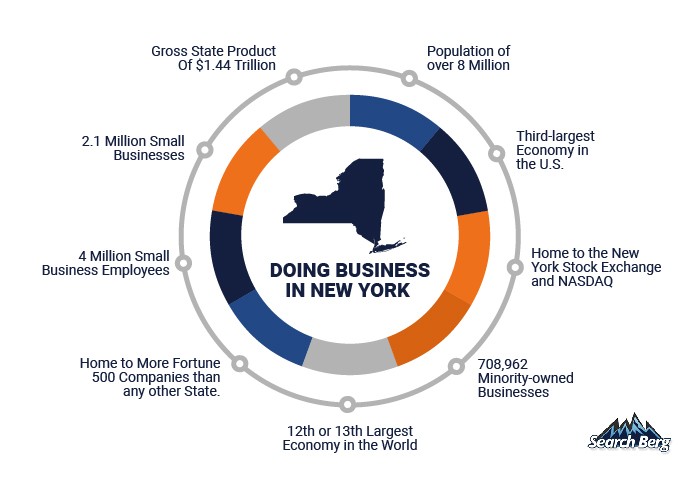
According to a New York Small Business Profile, 2018 report by the US Small Business Administration, top industries in New York include: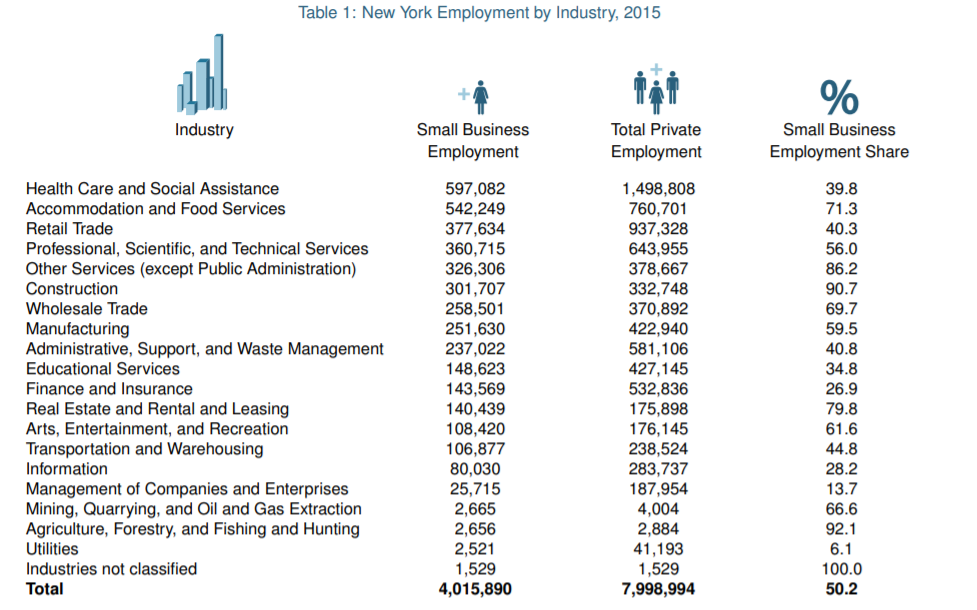
Table 1: New York Employment by Industry, 2015
Source: US Small Business Administration
Knowing When To Grow
There’s no denying that businesses need to look for way to be better, to become more efficient or to offer better products. But a lot of businesses hit the acceleration on growth and end up growing too soon or too quickly. Yes, there is such a phenomenon. And no, it’s not good.
Sustainable growth
is the name of the game. You grow at a rate that allows you to restrategize and reallocate your resources.
So how can you grow your NY business to take it to the next level? How does the evolving economic landscape translate into revenue for New York businesses? How can you sustain that growth to ensure your business thrives in the long run? We’ll also touch upon how online marketing and SEO play into this equation?
We’ve broken down the top strategies to help you kick things off!
If you’re a small business owner operating anywhere in New York, you need to comply with several local, state and federal laws and regulations. For instance, let’s say you own a restaurant in SoHo; you will need building permits, health permits, signage permits, etc. Research these laws carefully to avoid hefty penalties.
The good thing is, you have the SBA Office of Advocacy that provides information and guidance in addition to giving you a platform to voice your opinions as a small business. Furthermore, you can visit the Regulatory Alerts page on the SBA website that offers updates that specifically affect small business owners. Here’s how you can apply for licenses and permits.
Work closely with these state agencies to eliminate—or at the very least—reduce the regulatory burden.
2. Defining Your Target Market in New York
Who is your target audience?
If you don’t have a hyper-specific answer to this question, you’re never going to be able to grow as a business. You can’t be one of those brands that make “we target everyone” the slogan of their business. Because the truth is, if you’re targeting “everyone”, you’re targeting no one.
Keep in mind;
your business is evolving; consumer needs are evolving; what was relevant in 2015 is no longer relevant in 2020. Focus on specific geographical trends.
For example, certain trends making waves in New York are:
- The rise in the fintech industry
- Brooklyn algorithm startups
- The rise of food tech startups
- Big data and analytics
- New Yorkers heading to the suburbs
A few tips:
- Look for common characteristics among your current client base.
- See who your competitors are targeting to identify a niche they’re not catering to.
- Scan your social media pages to see the kind of people who engage with your business most.
- Check Google Analytics to identify which social network drives the most traffic using the referral traffic report.
Some questions you should be asking:
- What does your company value? <take cue from here>
- What are your best selling products/services?
- What is their age?
- Where do they live?
- What is their socioeconomic status?
- What do they want?
- What is their lifestyle?
- What is their spending power and patterns?
- What are the primary uses of your products/services?
- What are the secondary uses of your products/services?
- How long have they been customers?
Remember
Identifying your target audience will help you and your marketing team create more focused messages that will have an impact. The more structured and thorough your listing is, the more likely it is for your business to appear in the Google 3-Pack.
3. Play Up that Unique Selling Proposition (USP)
There may be an immediate success when you replicate an existing business model. Your competitor in Tribeca creates a clothing line for kids. You recognize there’s growth potential there; no denying it.
It’s safe, it has a proven track record, and it works.
So you introduce a kids’ clothing line too. After all, you need to catch up, right? But there’s no USP here. There’s nothing that makes YOU different. In order to expand your NY business, you don’t just have to catch up; you need to stay ahead of the game.
Your USP—your brand identity—does that for you.
Instead of another kids’ clothing line, how about environmentally-friendly, zero-allergen clothing line? You just knocked that one right out of the park!
4. Split Test Your Marketing Strategies
AKA A/B testing lets you try out different strategies to identify which marketing idea yields the most returns or conversions.
Your website or social media page may be attracting traffic. But is it converting? Is it translating into dollars?
Let say you launch a new website; does the “Yay, Let’s Shop” CTA button perform better than the “Buy Now” CTA?
Other ideas you could run A/B testing on:
- The size of the CTA: Bigger isn’t always better. And less isn’t always more.
- Free shipping information
- Pricing display
- Color and placement of the CTA
- Kind of images
- Navigation menu
You can use Google Analytics to initiate, run, and manage these experiments.
5. Create a Winning Social Media Marketing Strategy
72% of Americans use social media today. Seventy-two.
That’s a lot by any standard.
Small businesses haven’t let this alarming statistic go by unnoticed.
As a quick, easy, and dirt cheap way to engage with a wide audience, social media is a clear winner any way you look at it. It’s no wonder that 77% of small businesses in the U.S. have a social media marketing strategy in place.
You don’t need to follow suit; there are already way too many brands doing that and regurgitating run-of-the-mill strategies. Cookie-cutter social media tactics will throw your business in the rubble instead of making it stand out.
Here’s what you need to do to get people talking about your NY business (for the right reasons) and maximize engagement.
Start by creating a unique, genial, and unforgettable brand identity.
Let’s look at why this matters.
Think “glazed goodness” and visuals of Krispy Kreme donuts crowd your mind. That’s impeccable product quality for you.
However, the company isn’t just known for its mouthwatering sweet delights; it’s also recognized for its witty, empathetic, and all-round feel-good brand identity.
Went to a @krispykreme today for the BOGO promotion and was denied because I’m not a teacher.
— Bryan Carpenter (@bryan_carpenter) August 11, 2020
So I guess this is now a @krispykreme stan account. pic.twitter.com/VMoKqv58MM
— Grotto Gear (@GrottoGear) August 28, 2020
Notice how their social media strategy checks off all the boxes: timely, remedial, quick-witted, good-humored, and personalized.
Instead of copy-pasting a generic response—“We’re so sorry this happened. Please email us so we can set things right”—they go the extra mile to make customers feel special.
If you scroll through their page, you’ll marvel at the consistency and quality of their social media activity.
And it doesn’t stop there.
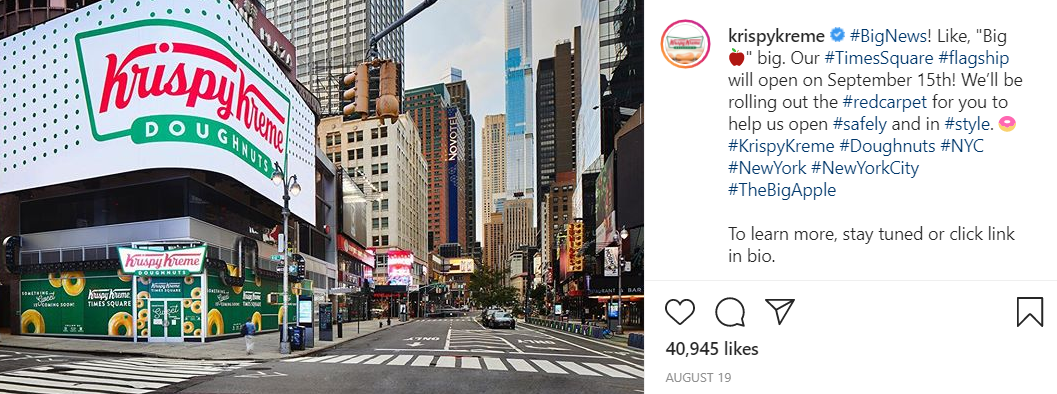
Their social media pages stand out for their winning New York-friendly optimization strategies. The company recently opened a flagship store in New York and optimized their social media updates accordingly by using NYC-based hashtags to target local customers.
If you run a small business, doing grand reveals may be out of the question.
Optimize your social media pages by using relevant hashtags, providing ample links, posting engaging polls, and launching small-scale giveaways.
The outcome?
Impressive audience engagement and retention—each of which is essential for your small business development.
Infuse each post with hints of your brand identity to connect with your audience and humanize your brand.
Consistency is key here. As long as you check off all these boxes and keep your pages up and running in the long run, you’ll continue to generate more leads.
6. Leverage SEO
New York SEO services are a goldmine for local businesses. In fact, we’d go so far as to say they’re your golden ticket to consistent and measurable growth.
So how do you do SEO in New York? Before we get into it, let’s unpack the basics.
Search engine optimization (SEO) is the process of creating and optimizing content to attract more traffic (customers) and rank higher on Google.
Sounds like a mouthful?
In other words, it’s a neat trick to help your content become more visible on the web.
How does that help?
As more people view your content, they’re more likely to engage with it and take a desired business action (buy your products/services, follow your social media pages, sign up for emails, etc.).
Let’s switch to customer mode to gauge how SEO does the trick. Let’s say you’re a customer looking for IT services in New York. Here are the top results you’d get from a quick Google search: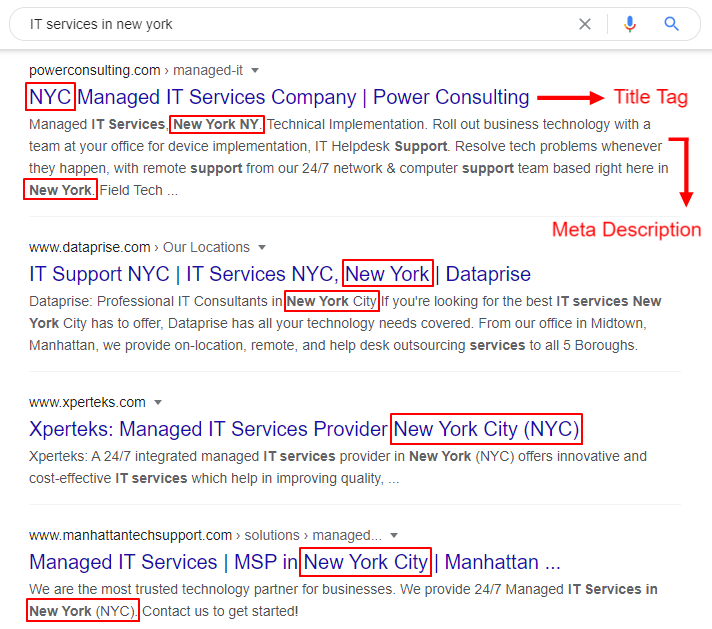
Notice how each landing page is meticulously optimized for location—New York, in this case. From the title tag (the main heading) to the meta description (the 1–3-line descriptor of the title), each page element includes location-friendly keywords.
This is a masterclass in local SEO for New York.
It’s quick, it’s easy, and it works like a charm.
With over 75% of people refusing to scroll past the first page of search results—who has the time, right?—local SEO propels your page to the top.
The outcome? More impressions, clicks, and conversions.
Done and dusted?
Not quite.
In fact, this only scratches the surface.
Here’s what you need to do to set yourself apart from your competitors and keep your business growing in the long run.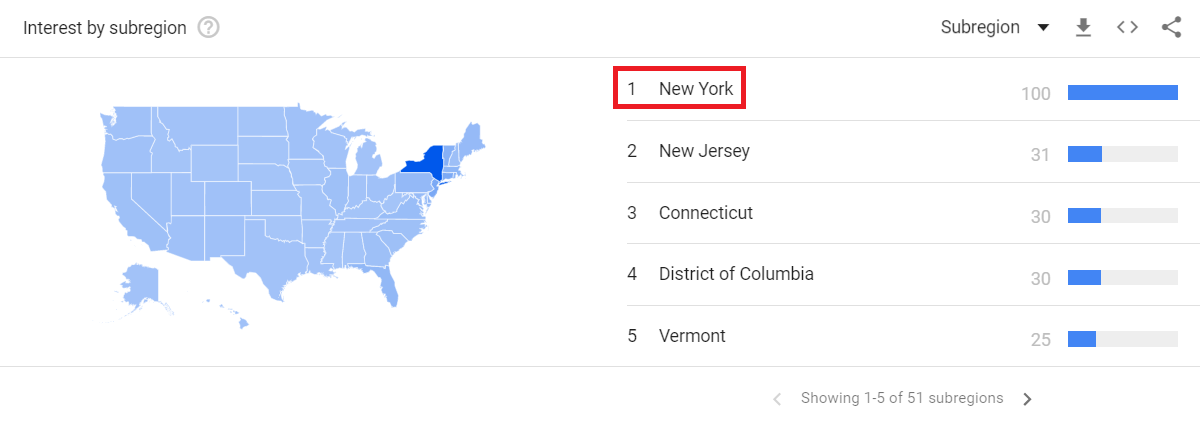
If your audience is based in New York, their search preferences will be customized accordingly.
From “plumbing services in the Bronx” and “hiking gear in Manhattan” to “best natural supplements near me” and “home office chairs in New York,” the search queries will be hyper-specific and relevant.
If you’re looking to maximize your reach, your keyword research strategy should be top-notch.
This is where Google Trends comes in.
The platform is amazing. It offers you a glimpse into the top trends for a specific location and further splinters them into relevant categories—news, events, entertainment, etc., you name it! With a few clicks, you can get an overview of what your target audience is interested in.
Here’s how this information works in your favor:
As you keep up with customer interest, you can create new content accordingly, tweak your product/service pages, and create location pages to maximize reach.
If Google Trends isn’t cutting it for you, get in touch with keyword specialists who know the ins and outs of each industry in New York and can help your business gain an edge.
Here are some stellar examples of how to fuse region-specific keywords with local trends to drive engagement: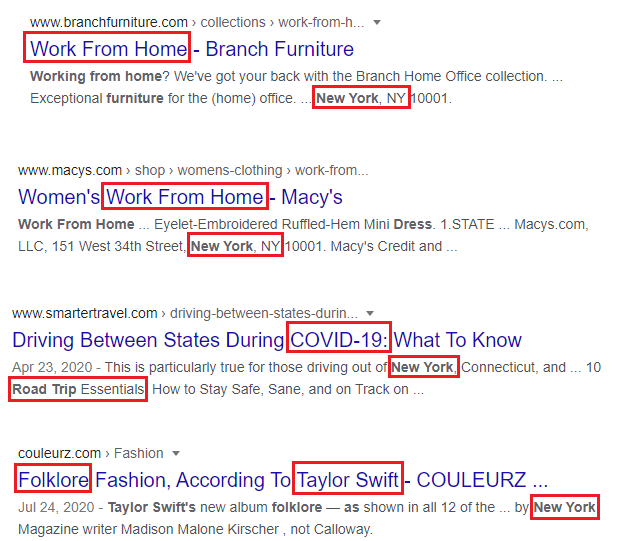
From focusing on work-from-home to COVID-19 to Taylor Swift’s trending album “Folklore,” these brands have expertly identified key trends and married them with the moneymaking local keyword “New York.”
A recipe for success, and one that isn’t too complex to recreate.

Depending on your industry, create a winning strategy that combines these two key factors. Cover different kinds of content, including blogs, articles, infographics, and press releases.
Sprinkle some keyword magic onto your product/service pages as well to maximize your chances of landing the Google 3-Pack—the top three search results on Google.
If it sounds like too much to take on, our experts are always here to help!
SEO for lead generation is ultimately one of the most effective ways to grow your small business and build a wide audience. At Global-marketing Inc., we’ll see your project through to perfection so you’re all set to dominate your niche.
Ready to kick-start your New York SEO strategy? Our pros can help.
Click here to request a free proposal
and watch your business grow!
7. Use Google My Business to Grow Your Business Online
Ever caught yourself wondering whether online reviews actually matter?
You’ve heard about their popularity. You’ve also heard that your business should be backed up by powerful testimonials and reviews that influence potential customers. But do they actually live up to the hype, or is it all big talk?
Let’s dive deeper.
According to research, 88% of people take reviews into consideration when making a buying decision.
That’s not all.
A staggering 82% of customers actively look for negative reviews to determine whether they should proceed with a purchase or look for alternatives.
Reviews—both positive and negative—can respectively make or break your business.
Leave negative reviews/mentions be without taking remedial action and your sales will take a dip. Fail to adequately solicit positive reviews and you’ll notice that your conversions aren’t as high as you’d like them to be.
So how do you close this Pandora’s box? And how do you strike the perfect balance between maximizing positive reviews and minimizing negative reviews?
You turn to Google My Business.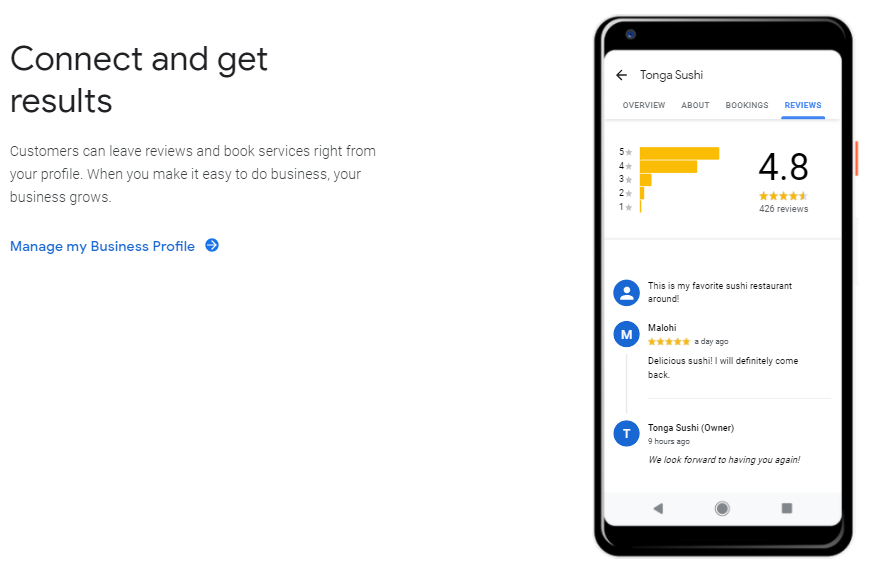
The powerful platform is the crème de la crème of online review platforms.
By claiming and optimizing your listing, you can engage more customers, maximize positive reviews, effectively respond to negative reviews, and get your business on the map.
In short, it’s a surefire way to grow a small NY business organically.
Here’s how you can start off on the right foot.
Make sure your listing is accurately filled and updated. From the name, address, and phone number (NAP) to the URL, business hours, and categories, each detail should be checked off to a tee.
Here’s what a comprehensive Google My Business listing looks like:


Not only are the essentials perfectly filled out, but they’ve also taken care of additional details—including the FAQs.
As a rule of thumb, cover as many bases as possible.
The more structured and thorough your listing is, the more likely it is for your business to appear in the Google 3-Pack.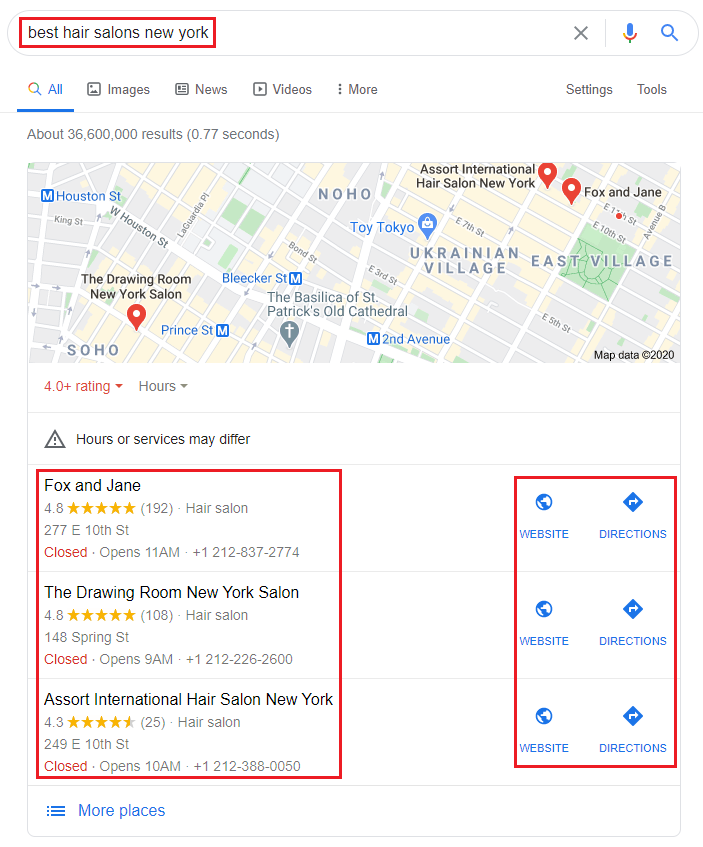
If you take a closer look at the 3-Pack for the search query “best hair salons in New York,” you’ll notice that all the details are meticulously filled in and the ratings are stellar.
As you accumulate more positive reviews on the platform, you’ll rank higher on local search engine result pages (SERPs).
To maximize flattering reviews, make sure you verify your business, actively request reviews, and keep your listing updated.
When it comes to tackling negative reviews, adopt an empathetic and remedial approach. Take your time to understand the complaint, adequately make up for it, and follow up with the customer once the issue has been resolved.
Little do you know, you could end up turning a negative review into a positive one with timely, supportive, and amiable resolution!
Need more insight into how to optimize your Google My Business listing? Check out our previous blog that covers the ins and outs of Google My Business optimization.
8. Make Mobile-Friendliness a Priority
- 84% of all local searches are from mobile phones
88% of people who search for a business on their phone end up visiting the store within a week
If your website operates
seamlessly on desktop but isn’t optimized for mobile, you’re potentially losing hundreds or thousands of customers—perhaps even more.
While smartphones may have been popular among the younger generation in the 2010s, they’ve become a staple for just about anyone in the 2020s.
No matter who your target audience is—Gen X, millennials, Gen Z, or baby boomers—creating a mobile-friendly website should be your top priority.
Let’s face it.
You’d rather search for products/services on your phone than crack open your laptop and go through the motions.
Rings true?
It does for the 19 million inhabitants of New York as well.
Create and optimize a seamless and eye-catching mobile-friendly website to grow your business fast. You’ll be taken aback by the much-needed boost in impressions, clicks, conversions, and revenue.
If you’re just getting started, make sure your mobile-friendly website is equipped with:
- Compelling CTAs
- High page speed
- Easy and clean navigation
- Engaging graphics
Test your website beforehand to ensure it runs seamlessly. You can also take Google’s Mobile-Friendly Test to get a better idea of how your website is performing.
It may take a while to get things right but once you’re done, you’ll reap the benefits of stellar engagement and conversions!
Additional Resources
Empire State Development’s Small Business Division
U.S. SBA District Office for New York
The Final Word
In this blog, we covered the top strategies to grow your NY business.
We delved into the key elements—social media marketing, Google My Business, mobile-friendliness, and how to do SEO for your New York business—to help you get a firm grasp on how to rank higher and sustain a wide audience.
When it comes to consistent business growth, taking the reins can prove a little tricky.
If you lack experience and expertise, things can easily go south despite your best efforts.
At Global-marketing Inc., we don’t want that to happen.
If you’re looking to hit the ground running on your first attempt, we’ve got you.
Our New York SEO services are designed to help NY businesses stand out in their industry, reach a wide audience, and maximize sales.












